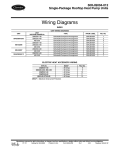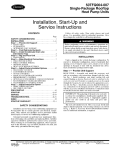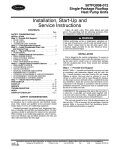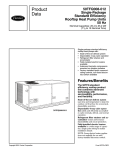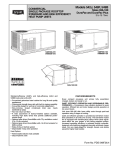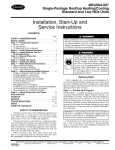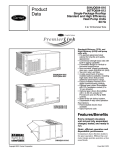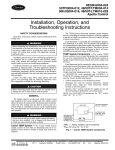Download Carrier APOLLO CONTROL 50HJQ004-016 Specifications
Transcript
50TFQ004-012 Single Package Rooftop Heat Pump Units Wiring Diagrams DIAGRAM INDEX DIAGRAM INDEX Unit 50TFQ 004,005 006 007 008-012 Voltage-Phase-Hertz 208/230-1-60 208/230-3-60 460-3-60 575-3-60 208/230-1-60 208/230-3-60 460-3-60 575-3-60 208/230-3-60 460-3-60 575-3-60 208/230-3-60 460-3-60 575-3-60 UNIT SCHEMATIC Type Schematic/Component Arrangement Schematic/Component Arrangement Schematic/Component Arrangement Schematic/Component Arrangement Schematic/Component Arrangement Schematic/Component Arrangement Schematic/Component Arrangement Schematic/Component Arrangement Schematic/Component Arrangement Schematic/Component Arrangement Schematic/Component Arrangement Schematic/Component Arrangement Schematic/Component Arrangement Schematic/Component Arrangement From Label Diagram 50DK508797 50DK508798 50DK508801 50DK508804 50DK508797 50DK508799 50DK508802 50DK508805 50DK508800 50DK508803 50DK508806 50DK508808 50DK508809 50DK508810 Figure No. 1 2 3 4 1 5 6 7 8 9 10 11 12 13 ELECTRIC HEAT ACCESSORY WIRING V-Ph-Hz 208/230-1-60 208/230-3-60, 460-3-60 208/230-1-60 208/230-3-60 460-3-60, 575-3-60 MOCP < 60 Amps < 60 Amps > 60 Amps > 60 Amps > 60 Amps Fig. No. 14 15 16 17 18 Manufacturer reserves the right to discontinue, or change at any time, specifications or designs without notice and without incurring obligations. PC 111 Catalog No. 535-00062 Printed in U.S.A. Form 50TFQ-2W Pg 1 3-03 Replaces: 50TFQ-1W Book 1 4 Tab 5a 5a OPTION AND ACCESSORY WIRING Description Apollo Controls Wiring — Including Indoor Air Quality Apollo Thermostat Wiring — Typical Convenience Outlet Schematic Durablade Economizer Wiring Differential Enthalpy Control (Durablade) Solid-State Enthalpy Control (Durablade) EconoMi$er Wiring EconoMi$er Dry Bulb Sensor Wiring EconoMi$er Enthalpy Sensor Wiring EconoMi$er Power Exhaust Wiring with Switch in the Actuator EconoMi$er Power Exhaust Wiring with Switch Outside the Actuator EconoMi$er2 Wiring Differential Enthalpy Wiring (EconoMi$er2) Fire and Smoke Control Wiring (EconoMi$er2) Indoor Air Quality Sensor Wiring (EconoMi$er2) Power Exhaust, 208/230V and 575V Units (EconoMi$er2) Power Exhaust for 460V Units (Economi$er2) Economi$er2 with PremierLink™ or 4-20 mA Control Emergency Heat Control with Single-Stage Electric Heater Emergency Heat Control with Two-Stage Electric Heater Factory-Installed Non-Fused Disconnect Schematic Motormaster® I Control Wiring Details Motormaster II Control Wiring Schematic Motormaster IV Control Wiring Schematic Novar Controls Wiring (EMT3051) Novar Controls Wiring (EMT2024) PremierLink Controls Wiring PremierLink Controls Wiring with Dual Terminal Block Remote Control Panel Wiring Smoke Detector Shutdown Time Guard II Device Two-Position Damper Wiring 62AQ Energy$Recycler Accessory Wiring (Typical) 50TFQ Unit Size 004-012 004-007 008-012 004-012 004-012 004-012 004-012 004-012 004-012 004-012 004-012 004-012 004-012 004-012 004-012 004-012 004-012 004-012 004-012 004-007 008-012 004-007 008-012 004-012 004-012 004-007 008-012 004-007 008-012 004-012 004-012 004-012 004-012 004-012 004-012 004-012 004-012 004-012 Fig. No. 19 20 21 22 23 24 25 26 27 28 29 30 31 32 33 34 35 36 37 38 39 40 41 42 43 44 45 46 47 48 49 50 51 52 53 54 55 56 Serial Number From 2492Gxxxxx From 0395Gxxxxx From 0798Gxxxxx From 3295Gxxxxx* From 3295Gxxxxx* From 3295Gxxxxx* 2099Gxxxxx – 0702Gxxxxx† 2099Gxxxxx – 0702Gxxxxx 2099Gxxxxx – 0702Gxxxxx 2099Gxxxxx – 4501Gxxxxx 4501Gxxxxx – 0702Gxxxxx From 0802Gxxxxx From 0802Gxxxxx From 0802Gxxxxx From 0802Gxxxxx From 0802Gxxxxx From 0802Gxxxxx From 0802Gxxxxx From 0395Gxxxxx From 2900Gxxxxx From 2900Gxxxxx From 4601Gxxxxx From 4002Gxxxxx From 0802Gxxxxx *Durablade Economizer was a factory-installed option (FIOP) until 2/15/02; it is currently available only as a field-installed accessory. †EconoMi$er wiring in Fig. 27 is generic (for units produced from 5/99 to 2/02) with the exception of the way the power exhaust switch is wired. Refer to Fig. 30 and 31 for more detailed power exhaust switch information. 2 SEQUENCE OF OPERATION 50TFQ004-012 Units energized and the position of the economizer damper will be determined by the supply-air temperature. Compressor no. 2 (50TFQ008-012) is locked out. When the second stage of cooling is satisfied, the compressor, RVS2, and outdoor-fan motor(s) will be deenergized. The damper position will be determined by the supply-air temperature. When the first stage of cooling is satisfied, the damper will move to fully closed position. When using continuous fan, the damper moves to minimum position. COOLING UNITS WITH ECONOMI$ER (EconoMi$er, Johnson Actuator, was produced from Unit Serial Numbers from 2009Gxxxxx to 0702Gxxxxx) (Sizes 004-007) — When the outdoor-air temperature (OAT) is above the ECON SP set point and the room thermostat calls for Stage 1 cooling, terminals G and Y1 are energized. The indoor-fan contactor (IFC), reversing valve solenoid (RVS1) and compressor contactor no. 1 (C1) are energized and indoor-fan motor, compressor no. 1 and outdoor fans start. The EconoMi$er damper modulates to minimum position. The outdoor-fan motor(s) runs continuously while unit is cooling. After the thermostat is satisfied, the damper modulates to the fully closed position when the IFM is deenergized. When the OAT is below the ECON SP setting and the room thermostat calls for Stage 1 cooling (R to G + Y1), the EconoMi$er modulates to the minimum position when the IFM is energized. The EconoMi$er provides Stage 1 of cooling by modulating the return and outdoor-air dampers to maintain a 55 F supply air set point. If the supply-air temperature (SAT) is greater than 57 F, the EconoMi$er modulates open, allowing a greater amount of outdoor air to enter the unit. If the SAT drops below 53 F, the outdoor air damper modulates closed to reduce the amount of outdoor air. When the SAT is between 53 and 57 F, the EconoMi$er maintains its position. If outdoor-air alone cannot satisfy the cooling requirements of the conditioned space, and the OAT is above the MECH CLG LOCKOUT set point, the EconoMi$er integrates free cooling with mechanical cooling. This is accomplished by the strategies below. NOTE: Compressor has a 2-minute Minimum On, Minimum Off, and Interstage delay timer. 1. If Y1 is energized, and the room thermostat calls for Y2 (2-stage thermostat), the compressor, RVS1 and OFM are energized. The EconoMi$er damper is maintained at its current position. 2. If Y1 is energized for more than 20 minutes, and Y2 is not energized (whether or not a 2-stage thermostat is used), the compressor, RVS1 and OFM are energized. The EconoMi$er damper is maintained at its current position. 3. If Y1 is energized, the compressor and RVS1 are already energized (see Step 2) and the room thermostat calls for Y2, the compressor continues to operate. 4. If compressor and RVS1 are energized and the thermostat is satisfied, the compressor, RVS1, the OFM, and IFM are deenergized and the EconoMi$er modulates closed. When the OAT is below the MECH CLG LOCKOUT set point, the compressors remain off. COOLING, UNITS WITH ECONOMI$ER (EconoMi$er, Johnson Actuator, was produced from Unit Serial Numbers from 2009Gxxxxx to 0702Gxxxxx) (Sizes 008-014) — When the outdoor-air temperature (OAT) is above the ECON SP set point and the room thermostat calls for Stage 1 cooling, terminals G and Y1 are energized. The indoor-fan contactor (IFC), reversing valve solenoid (RVS1) and compressor contactor no. 1 (C1) are energized and indoor-fan motor, compressor no. 1 and outdoor fans start. The EconoMi$er damper modulates to minimum position. The outdoor-fan motor(s) runs continuously while unit is cooling. After the thermostat is satisfied, the damper modulates to the fully closed position when the IFM is deenergized. COOLING, UNITS WITHOUT ECONOMIZER — When thermostat calls for cooling, terminals G and Y1 are energized. The indoor-fan contactor (IFC), reversing valve solenoid (RVS1) and compressor contactor no. 1 (C1) are energized and indoor-fan motor, compressor no. 1, and outdoor fans start. The outdoor-fan motor(s) run continuously while unit is cooling. On 50TFQ008-012 units, if the thermostat calls for a secondstage of cooling by energizing Y2, compressor contactor no. 2 (C2) and reversing valve solenoid (RVS2) are energized and compressor no. 2 starts. HEATING, UNITS WITHOUT ECONOMIZER (Sizes (004-007) — Set system switch at AUTO. or HEAT position. Set thermostat at desired temperature. When the thermostat calls for heat, the IFC, outdoor-fan contactor (OFC), and compressor contactor are energized. The RVS is deenergized and switches position, and the indoor fan, outdoor fan, and compressor are energized. If the thermostat calls for a second stage of heat, the heater contactor (HC) is energized and starts the electric heaters. When the space temperature approaches the heating temperature set point, heating stages cycle off. HEATING, UNITS WITHOUT ECONOMIZER (Sizes 008-012) — Upon a request for heating from the space thermostat, terminal W1 will be energized with 24 v. The IFC, outdoor-fan contactor (OFC), C1, and C2 will be energized. The reversing valves switch position and deenergize, and the indoor fan, outdoor fan, compressor no. 1, and compressor no. 2 are energized. If the space temperature continues to fall while W1 is energized, W2 will be energized with 24 v, and the heater contactor(s) (HC) will be energized, which will energize the electric heater(s). When the space thermostat is satisfied, W2 will be deenergized first, and the electric heater(s) will be deenergized. Upon a further rise in space temperature, W1 will be deenergized, and the compressors will turn off. COOLING, UNITS WITH DURABLADE ECONOMIZER — When the outdoor-air temperature is above the outdoor-air thermostat (OAT) setting and the room thermostat calls for cooling, compressor contactor no. 1 is energized to start compressor no. 1 and the outdoor-fan motor(s). RVS1 (reversing valve solenoid) is energized. The indoor-fan motor is energized and the economizer damper moves to the minimum position. Upon a further call for cooling, compressor contactor no. 2 will be energized (50TFQ008-012), starting compressor no. 2. RVS2 is energized. After the thermostat is satisfied, the damper moves to the fully closed position. When using continuous fan, the damper moves to minimum position. When the outdoor-air temperature is below the OAT setting and the thermostat calls for cooling, the economizer dampers move to the minimum position. If the supply-air temperature is above 57 F, the damper continues to open until it reaches the fully open position or until the supply-air temperature drops below 52 F. When the supply-air temperature falls to between 57 F and 52 F, the damper will remain at an intermediate open position. If the supply-air temperature falls below 52 F, the damper will modulate closed until it reaches the minimum position or until the supply-air temperature is above 52 F. When the thermostat is satisfied, the damper will move to the fully closed position. When using continuous fan, the damper moves to minimum position. If the outdoor air alone cannot satisfy the cooling requirements of the conditioned space, economizer cooling is integrated with mechanical cooling, providing second-stage cooling. Compressor no. 1 reversing valve solenoid (RVS1) and the outdoor fan will be 3 HEATING, UNITS WITH ECONOMIZER INCLUDING DURABLADE, ECONOMI$ER (Johnson) OR ECONOMI$ER2 (Sizes 008-012) — Upon a request for heating from the space thermostat, terminal W1 will be energized with 24 v. The IFC, outdoor-fan contactor (OFC), C1, and C2 will be energized. The reversing valves switch position and the indoor fan, outdoor fan, compressor no. 1, and compressor no. 2 are energized. The economizer damper blade opens to minimum position. If the space temperature continues to fall while W1 is energized, W2 will be energized with 24 v, and the heater contactor(s) (HC) will be energized, which will energize the electric heater(s). When the space thermostat is satisfied, W2 will be deenergized first, and the electric heater(s) will be deenergized. Upon a further rise in space temperature, W1 will be deenergized, and the reversing valve solenoids (RVS1 and RVS2) will be energized. DEFROST (Sizes 004-007) — As frost builds up on the outdoor coil, the coil temperature drops below 28 F. When this outdoor-coil temperature drop is sensed by the defrost thermostat (DFT) and the defrost timer is at the end of a timed period (adjustable at 30, 50, or 90 minutes), the unit operates in a defrost cycle controlled by the defrost timer and thermostat. During this cycle, the reversing valve solenoid (RVS) is energized and the outdoor fan shuts off. The electric heaters (if installed) will be energized. The unit continues to defrost until the coil temperature as measured by DFT reaches 65 F, or the duration of defrost cycle completes a 10-minute period. At the end of the defrost cycle, the electric heaters (if installed) and the reversing valve will be deenergized, and the outdoor-fan motor will be energized. The unit will now operate in the Heating mode. If the thermostat is satisfied during a defrost cycle, the unit will continue in the Defrost mode until the time or temperature constraints are satisfied. DEFROST (Sizes 008-012) — When the temperature of the outdoor coil drops below 28 F as sensed by the defrost thermostat (DFT2) and the defrost timer is at the end of a timed period (adjustable at 30, 50, or 90 minutes), reversing valve solenoids (RVS1 and RVS2) are energized and the OFC is deenergized. This switches the position of the reversing valves and shuts off the outdoor fan. The electric heaters (if installed) will be energized. The unit continues to defrost until the coil temperature as measured by DFT2 reaches 65 F, or the duration of defrost cycle completes a 10-minute period. During the Defrost mode, if circuit 1 defrosts first, RVS1 will oscillate between Heating and Cooling modes until the Defrost mode is complete. At the end of the defrost cycle, the electric heaters (if installed) will be deenergized; the reversing valves switch and the outdoor-fan motor will be energized. The unit will now operate in the Heating mode. If the space thermostat is satisfied during a defrost cycle, the unit will continue in the Defrost mode until the time or temperature constraints are satisfied. When the OAT is below the ECON SP setting and the room thermostat calls for Stage 1 cooling (R to G + Y1), the EconoMi$er modulates to the minimum position when the IFM is energized. The EconoMi$er provides Stage 1 of cooling by modulating the return and outdoor-air dampers to maintain a 55 F supply air set point. If the supply-air temperature (SAT) is greater than 57 F, the EconoMi$er modulates open, allowing a greater amount of outdoor air to enter the unit. If the SAT drops below 53 F, the outdoor air damper modulates closed to reduce the amount of outdoor air. When the SAT is between 53 and 57 F, the EconoMi$er maintains its position. If outdoor-air alone cannot satisfy the cooling requirements of the conditioned space, and the OAT is above the MECH CLG LOCKOUT set point, the EconoMi$er integrates free cooling with mechanical cooling. This is accomplished by the strategies below. NOTE: Compressors have a 2-minute Minimum On, Minimum Off, and Interstage delay timer. 1. If Y1 is energized, and the room thermostat calls for Y2 (2-stage thermostat), compressor no. 1, RVS1 and OFM are energized. The EconoMi$er damper is maintained at its current position. 2. If Y1 is energized for more than 20 minutes, and Y2 is not energized (whether or not a 2-stage thermostat is used), compressor no. 1, RVS1 and OFM are energized. The EconoMi$er damper is maintained at its current position. 3. If Y1 is energized, and compressor no. 1 is already energized (see Step 2) and the room thermostat calls for Y2, compressor no. 1 continues to operate. If Y2 remains energized for more than 20 minutes, compressor no. 2 and RVS2 are energized. NOTE: Compressor no. 2 cannot be energized unless there is a signal for Y2 from the space thermostat. 4. If compressor no. 2 is energized, and the Y2 signal from the thermostat is satisfied, compressor no. 1 and 2, RVS1, RVS2 and ODF are deenergized. Reasserting Y2 will start compressor no. 1 and (after a 20-minute interstage delay) compressor 2. 5. If compressor no. 1 is energized and the thermostat is satisfied, compressor no. 1, the OFM, RVS1 and IFM are deenergized and the EconoMi$er modulates closed. HEATING, UNITS WITH ECONOMIZER INCLUDING DURABLADE, ECONOMI$ER (Johnson) OR ECONOMI$ER2 (Sizes 004-007) — Set system switch at AUTO. or HEAT position. Set thermostat at desired temperature. When the thermostat calls for heat, the IFC, outdoor-fan contactor (OFC), and compressor contactor are energized. The economizer damper blade opens to minimum position. The RVS is deenergized and switches position, and the indoor fan, outdoor fan, and compressor are energized. If the thermostat calls for a second stage of heat, the heater contactor (HC) is energized and starts the electric heaters. When the space temperature approaches the heating temperature set point, heating stages cycle off. The reversing valve solenoid is reenergized. 4 LEGEND AHA AWG BR C CAP CB CC CH CLO CO2 COC COH COM COMMS COMP CR CTD D DAT DB DFT DM DR DX EC ECON EFC EPS EQUIP ER FC FPT FU GND GVR HC HM HPS HR HTR HV TRAN I IAQ IFC IFM IFMOVL IFR IGC LED LPS LSM — — — — — — — — — — — — — — — — — — — — — — — — — — — — — — — — — — — — — — — — — — — — — — — — — — — LTLO MCA MGV MTR NC NEC NO OAT OATC OATH OCR OFC OFM OLR P, PL QT R RVS SAT SW SW1 SW2 SW3 SW4 TB TC TDR TH TRAN VVT® Adjustable Heat Anticipator American Wire Gage Blower Relay Contactor, Compressor Capacitor Circuit Breaker Cooling Compensator Crankcase Heater Compressor Lockout Carbon Dioxide Cool Changeover Relay Heat Changeover Relay Common Communications Compressor Motor Control Relay Compressor Time Delay Diode Discharge Air Thermistor Defrost Board Defrost Thermostat Damper Motor Defrost Relay Direct Expansion Enthalpy Control Economizer Exhaust Fan Contactor Emergency Power Supply Equipment Economizer Relay Fan Contactor Freeze Protection Thermostat Fuse Ground Gas Valve Relay Heater Contactor (Electric Heater) Humidity Relay High-Pressure Switch Heater Relay Heater High-Voltage Transformer Ignitor Indoor Air Quality Indoor-Fan Contactor Indoor-Fan Motor Indoor-Fan Motor Overload Switch Indoor-Fan Relay Integrated Gas Controller Light Emitting Diode Low-Pressure/Loss-of-Charge Switch Limit Switch (Manual Reset) — — — — — — — — — — — — — — — — — — — — — — — — — — — — — — Low Temp Cooling Lockout Minimum Circuit Amps Main Gas Valve Motor Normally Closed National Electrical Code Normally Open Outdoor-Air Thermostat Outdoor Air Thermostat (Cool) Outdoor Air Thermostat (Heat) Occupied Relay Outdoor-Fan Contactor Outdoor-Fan Motor Overload Relay Plug Quadruple Terminal Relay Reversing Valve Solenoid Supply-Air Thermostat Switch Switch, Fully Open Switch, Fully Closed Switch Minimum Vent Position Switch Maximum Vent Position Terminal Block Thermostat, Cooling Time-Delay Relay Thermostat, Heating Transformer Variable Volume/Variable Temperature Field Splice Terminal (Marked) Marked Wire Terminal (Unmarked) Terminal Block Splice Splice Marked Factory Wiring Field Control Wiring Field Power Wiring Accessory or Optional Wiring To indicate common potential only. Not to represent wiring. 5 NOTES FOR FIG. 1 1. If any of the original wire furnished must be replaced, it must be replaced with Type 90 C wire or its equivalent. 2. Thermostat: HH07AT170, 172, 174, and P272-2783. Subbase: HH93AZ176, 178 and P272-1882, 1883. 3. Set heat anticipator at .8 amp for 1st stage and .3 amp for 2nd stage. 4. Use copper conductors only. 5. Use copper, copper-clad aluminum or aluminum conductors. 6. CB MUST VOLTAGE TRIP RATING MFG. PT. NO. AMPS Potter & Brumfield 24 V 3.2 W2BX-1024-3.2 NOTES FOR FIG. 2, 8, 11, 12, 13 1. If any of the original wire furnished must be replaced, it must be replaced with Type 90 C wire or its equivalent. 2. Three-phase motors are protected under primary single phasing conditions. 3. Thermostat: HH07AT170, 172, 174, and P272-2783. Subbase: HH93AZ176, 178, and P272-1882, 1883. 4. Set heat anticipator at .8 amp for 1st stage and .3 amp for 2nd stage. 5. Use copper conductors only. 6. Use copper, copper-clad aluminum or aluminum conductors. 7. CB VOLTAGE MUST RATING MFG. PT. NO. TRIP AMPS Potter & Brumfield 24 V W2BX-1024-3.2 3.2 NOTES FOR FIG. 3, 4, 6, 7, 9, 10 5. Use copper conductors only. 6. CB VOLTAGE RATING MFG. PT. NO. 1. If any of the original wire furnished must be replaced, it must be replaced with Type 90 C wire or its equivalent. 2. Thermostat: HH07AT170, 172, 174, and P272-2783 Subbase: HH93AZ176, 178, and P272-1882, 1883. 3. Three-phase motors are protected under primary singlephasing conditions. 4. Set heat anticipator at .8 amp for 1st stage and .3 amp for 2nd stage. 24 V Potter & Brumfield W2BX-1024-3.2 MUST TRIP AMPS 3.2 NOTES FOR FIG. 5 5. Use copper conductors only. 6. Use copper, copper-clad aluminum or aluminum conductors. 7. CB MUST VOLTAGE TRIP RATING MFG. PT. NO. AMPS Potter & Brumfield 24 V 3.2 W2BX-1024-3.2 1. If any of the original wire furnished must be replaced, it must be replaced with Type 90 C wire or its equivalent. 2. Thermostat: HH07AT170, 172, 174, and P272-2783 Subbase: HH93AZ176, 178, and P272-1882, 1883. 3. Three-phase motors are protected under primary singlephasing conditions. 4. Set heat anticipator at .8 amp for 1st stage and .3 amp for 2nd stage. 6 Fig. 1 — Schematic/Component Arrangement; 50TFQ004-006; 208/230-1-60 7 SEE NOTE#3 AND 4 Fig. 2 — Schematic/Component Arrangement; 50TFQ004,005; 208/230-3-60 8 Fig. 3 — Schematic/Component Arrangement; 50TFQ004,005; 460-3-60 9 Fig. 4 — Schematic/Component Arrangement; 50TFQ004,005; 575-3-60 10 Fig. 5 — Schematic/Component Arrangement; 50TFQ006; 208/230-3-60 11 Fig. 6 — Schematic/Component Arrangement; 50TFQ006; 460-3-60 12 Fig. 7 — Schematic/Component Arrangement; 50TFQ006; 575-3-60 13 Fig. 8 — Schematic/Component Arrangement; 50TFQ007; 208/230-3-60 14 Fig. 9 — Schematic/Component Arrangement; 50TFQ007; 460-3-60 15 Fig. 10 — Schematic/Component Arrangement; 50TFQ007; 575-3-60 16 Fig. 11 — Schematic/Component Arrangement; 50TFQ008-012; 208/230-3-60 17 Fig. 12 — Schematic/Component Arrangement; 50TFQ008-012; 460-3-60 18 Fig. 13 — Schematic/Component Arrangement; 50TFQ008-012; 575-3-60 19 NO SINGLE POINT BOX REQUIRED OR CRSINGLE001A00 Fig. 14 — Electric Heater Power Wiring Connections Electric Cooling Units — 208/230-1-60 — Less Than 60 Amps MOCP NO SINGLE POINT BOX REQUIRED (Use Existing Space in Unit) OR CRSINGLE001A00 (Sizes 3 to 6 Tons) OR CRSINGLE006A00 (Sizes 71/2 and 81/2 Tons) OR CRSINGLE011A00 (Size 10 Tons) Fig. 15 — Electric Heater Power Wiring Connections Electric Cooling Units — 208/230-3-60, 460-3-60 — Less Than 60 Amps MOCP CRSINGLE004A00 CRSINGLE005A00 Fig. 16 — Electric Heater Power Wiring Connections — Heat Pump Units, 208/230-1-60 — Greater Than 60 Amps MOCP 20 CRSINGLE002A00 OR CRSINGLE007A00 OR CRSINGLE012A00 CRSINGLE003A00 OR CRSINGLE009A00 OR CRSINGLE015A00 CRSINGLE013A00 CRSINGLE017A00 Fig. 17 — Electric Heater Power Wiring Connections — Heat Pump Units, 208/230-3-60 — Greater Than 60 Amps MOCP CRSINGLE008A00 AND CRSINGLE014A00 CRSINGLE010A00 AND CRSINGLE016A00 Fig. 18 — Electric Heater Power Wiring Connections — Heat Pump Units, 460-3-60 and 575-3-60 — Greater Than 60 Amps MOCP 21 22 FILTER STATUS HUMIDITY SENSOR GRN BLK GRN BLK 2 1 87654321 BLK RED BLK RED GRN #11 #10 #10 #11 NC COM NO OAT SAT COOL 2 RELAY SINGLE ZONE RELAY PACK CIRCUIT BOARD 1 13 12 11 10 9 8 7 4 3 FAN RV 6 FIELDHEAT INSTALLED 5 JUMPERS†† 4 3 SINGLE ZONE 2 RELAY PACK 1 WITH AUXILARY YEL WHT BLK AO COM Y1 Y2 G B1 LED COM DAT COM REM POT COM CO2 COM CO2+ OAT COM OAH +15V CLG1 RAT CLG2 COM CONTROLLER RAH +15V 24 VAC 24 COM GND VIO PNK TAN VIO WHT RED DAT EC ACCESSORY ONLY OAT FAN HEAT 2 HEAT 1 NC HEAT 1 HEAT/FAN COM COOL 2 COOL 1 COOL COM R 24 VAC/10 VA C GROUND AUXILIARY RELAY** TO CARRIER HVAC UNIT FIELD SUPPLIED WIRING *Filter status switch and humidity sensor cannot function simultaneously. Only one sensor can be wired. †Such as a CO2 sensor. **Set auxiliary option to ‘‘2’’ — IAQ Control per VTS or VVT Installation Instructions. ††Field-installed Jumpers between 3,4 and 5,7. NOTE: When single zone relay pack is used on a VVT Monitor Only System, the monitor thermostat cannot control a damper. DM Fig. 19 — Apollo Controls Wiring — Including Indoor-Air Quality DX FAN STATUS 1 2 3 4 5 6 7 8 9 10 11 12 13 14 15 16 17 ALARM RELAY CONTACTS + 2-10VDC - SIG COM (J5-3) + 4-20mA (J5-2) WHT RED BLU YEL GRN IAQ STATUS† INDOOR AIR QUALITY (CO2) SENSOR (33ZCSENCO2) TYPICAL WIRING DIAGRAM H G 24 VAC OR + - 24 VDC ADDITIONAL SENSORS* TSP01 TERMINAL NUMBER WHT #1 RED #2 REMOTE ROOM TEMP. SENSOR NETWORK GROUND 24 V TRAN 24 VAC 20 VA (FIELD SUPPLIED) RED BRN GRN BLU PNK ECONOMI$ER OPTION/ACCESSORY Fig. 20 — Apollo Thermostat Wiring — 50TFQ004-007 (Typical) Fig. 21 — Apollo Thermostat Wiring — 50TFQ008-012 (Typical) 23 Fig. 22 — Convenience Outlet Schematic Fig. 23 — Durablade Economizer Schematic 24 A B TR C D SO TR1 SR + 2 + 24 VAC SUPPLY FROM 24 VAC SUPPLY FROM ECONOMIZER CONTROL SECTION (RED TO TR, BRN TO TR1) A TO SENSOR MOUNTED ON BACK OF CONTROL B S (HH57AC078 + SENSOR) 3 1 GRAY WIRE FROM ECONOMIZER HARNESS TR TR1 C SO D + SR + 2 3 CONTROL } ECONOMIZER SECTION (RED TO TR, BRN TO TR1) SENSOR MOUNTED } TO ON BACK OF CONTROL 620 ohm JUMPER GRAY WIRE FROM ECONOMIZER HARNESS 1 LED LED RED WIRE FROM ECONOMIZER SWITCH 3 (NORMALLY CLOSED) RED WIRE FROM ECONOMIZER SWITCH 3 (NORMALLY CLOSED) NOTE: Switches shown in the high enthalpy state. Terminals 2 and 3 close on enthalpy decrease. NOTES: 1. Remove factory-installed jumper across SR and + before connecting wires from HH57AC078 sensor. 2. Switches shown in high outdoor-air enthalpy state. Terminals 2 and 3 close on low outdoor air enthalpy relative to indoor air enthalpy. Fig. 25 — Wiring Connections for Solid-State Enthalpy Control (Durablade Economizer) Fig. 24 — Wiring Connections for Differential Enthalpy Control (Durablade Economizer) *Wiring is generic for all EconoMi$ers with the exception of the actuator. Refer to Fig. 29 and 30 for specific actuator production dates. Fig. 26 — EconoMi$er Wiring for Units Produced 5/1999 through 2/2002* 25 ECONOMI$ER CONTROLLER BROWN VIOLET OAT WHITE RED COM OAH +15 V RAT COM RAH +15 V CO2 (+) CO2 COM DAT COM REM POT COM LED COM BROWN VIOLET WHITE RED TEMP TEMP COM OUT PWR OUTDOOR AIR SENSOR TEMP TEMP COM OUT PWR RETURN AIR SENSOR CO2 SENSOR 24 V+ COM VAC SUPPLY AIR TEMPERATURE SENSOR PINK TEMP VIOLET TEMP Fig. 27 — EconoMi$er Dry Bulb Sensor Wiring Fig. 28 — Wiring Diagram for Field-Installed Enthalpy Sensors 26 RED GRAY H1 H2 X4 X2 X3 RED YEL BLU GRAY HT01AH850 (460 VAC) HT01AH859 (575 VAC) TO FUSED DISCONNECT X1 H1 H3 H2 H4 X4 X2 X3 X1 SECONDARY 230VAC SECONDARY 230VAC FIELD SUPPLIED WIRING BLACK BLACK COMPRESSOR 1 CONTACTOR OR 11 LT. BLUE 21 230VAC 13 BROWN 23 FAN 1 C1 GREEN/ YELLOW 4-PIN CONNECTOR PLUG 2 x 4 IN. HANDY BOX BLACK L1 1 BLUE L2 2 GREEN GND 3 4 3 6 9 2 5 8 1 4 7 B BLACK R1 24 VAC A BLUE L1 1 L2 2 GND 3 4 230 VAC 1 PHASE 3-PIN CONNECTOR PLUG ORANGE 1 YELLOW 2 BROWN BLACK BLACK BLUE LT. BLUE GREEN BROWN FAN 2 3 6 9 2 5 8 1 4 7 B BLACK C1 GREEN/ YELLOW R2 24 VAC A BLUE Fig. 29 — EconoMi$er Power Exhaust with the Switch Inside the Actuator (Units Produced 5/16/1999 - 11/5/2001) TOP SWITCH CAM POSITION INDICATOR TOP SWITCH WIRE TIE ANCHOR HOLE BOTTOM SWITCH CONNECTS TO 2-PIN CONNECTOR IN ECONOMIZER 2 1 +24 VAC RED TOP SWITCH NC NO COM COM RED BOTTOM SWITCH NC NO ORANGE YELLOW BROWN 1 2 CONNECTS TO THE 3-PIN CONNECTOR PLUG ON POWER EXHAUST 3 COM Fig. 30 — EconoMi$er Power Exhaust with Switch Outside of Actuator (Units Produced 11/5/2001 - 2/15/2002) 27 3 ECONOMISER2 CONTROLLER ACTUATOR NOTE 9 RED 24 VAC HOT BLACK 24 VAC COM BROWN BLACK TR TAN RUN SO + SR + 820 OHM NOTE 6 RESISTOR VIOLET NOTE 1 ECONOMIZER DRY BULB SENSOR 620 OHM RESISTOR NOTE 5 BLACK 5 1K 1S + WHITE NOTE 4 + - 1 2 3 4 T T1 P P1 WHITE Compressor Lockout N.C. 2K 2-10V OUT 4 BROWN 3 BLACK GRAY 5 GRAY BLUE 2 BLUE YELLOW 8 YELLOW VIOLET 6 VIOLET PINK 7 PINK 1 RED 10 WHITE 11 BROWN 9 ORANGE TR1 NOTE 7 1S1 - MINIMUM POSITION ADJUSTMENT FREE COOL Q MAXIMUM POSITION ADJUSTMENT AQ Q1 AQ1 SD1 AC AC1 PG PG1 + 2-10 VDC NOTE 2 CO2 SENSOR UNIT CONTROL EXHAUST FAN INDOOR FAN 12 } SD - NOTE 8 HARNESS AND PLUG NOTE 3 NOTES: 1. The standard EconoMi$er2 is shipped with a fixed dry bulb sensor. (Open 67 F — Close 52 F.) An adjustable dry bulb or enthalpy sensor can replace the fixed dry bulb. (See Note 6.) 2. CO2 sensor is optional. Field-installed accessory. See rooftop price pages for ordering data and pricing. Power for CO2 sensor should be provided by field-supplied transformer. 3. The HVAC unit is shipped with a jumper plug attached to the EconoMi$er2 harness. Remove the jumper plug and save for future use if economizer is removed. Connect the male side of plug (shown above) to the female side in HVAC unit. 4. 1S is an electronic switch that closes when powered by a 24 vac input. 5. Factory-installed 620-ohm, 1 watt, 5% resistor should be removed only when a HH57AC078 enthalpy sensor or CROASENR001A00 adjustable dry bulb is added to SR and + for differential sensing. 6. When replacing the fixed dry bulb sensor with an enthalpy or adjustable dry bulb, remove the 820-ohm resistor. 7. Compressor lockout (Open 35 F — Close 50 F). 8. See EconoMi$er2 Installation Instructions for details on locating and wiring supply air (mixed air) sensor. 9. Switch on actuator must be in run position for economizer to operate. 10. A 2-stage thermostat is recommended. 11. Before troubleshooting wiring, ensure that all the correct sensors have been installed (refer to EconoMi$er2 Installation Instructions). Fig. 31 — EconoMi$er2 Wiring (For Units Produced 2/18/02 - Present) ECONOMISER2 CONTROLLER TAN VIOLET SO + + S SR + TAN VIOLET + S HH57AC078 ENTHALPY OR CROASENPOO1A00 ADJUSTABLE DRY BULB (NOTE 1) HH57AC078 DIFFERENTIAL ENTHALPY OR CROASENPOO1A00 DIFFERENTIAL ADJUSTABLE DRY BULB (NOTE 2) NOTES: 1. Violet wire from SO terminal has a factory-installed 820-ohm in-line resistor. This resistor must be removed when replacing the standard fixed dry bulb with an optional enthalpy or adjustable dry bulb. 2. The standard economizer has a 620-ohm resistor between terminals SR and +. This resistor must be removed when adding differential enthalpy or differential adjustable dry bulb. Fig. 32 — Differential Enthalpy Wiring for EconoMi$er2 28 ECONOMISER2 ACTUATOR ECONOMISER2 CONTROLLER RED 24 VAC HOT BLACK 24 VAC COM BROWN BLACK TR TR1 SO + 4 BROWN 3 BLACK GRAY 5 GRAY BLUE 2 BLUE YELLOW 8 YELLOW VIOLET 6 VIOLET PINK 7 PINK 1 RED 10 WHITE 11 BROWN 9 ORANGE TAN SR + BLACK 820 OHM RESISTOR VIOLET ECONOMISER2 DRY BULB SENSOR 620 OHM RESISTOR 5 1K 1S + WHITE + 2 3 4 T T1 P P1 WHITE Compressor Lockout N.C. 2K 2-10V OUT - 1 1S1 - MINIMUM POSITION ADJUSTMENT FREE COOL MAXIMUM POSITION ADJUSTMENT Q1 AQ AQ1 SD SD1 UNIT CONTROL EXHAUST FAN INDOOR FAN 12 FIRE AND SMOKE CONTROL SHUTDOWN AC AC1 PG PG1 AIR CHANGE PURGE Fig. 33 — Fire and Smoke Control Wiring for EconoMi$er2 Fig. 34 — Indoor Air Quality Sensor Wiring for EconoMi$er2 29 } Q HARNESS AND PLUG TO HVAC UNIT CONTROL BOX (SEE NOTE 4) BLACK EXH. FAN #1 BLUE C2 BLACK BLACK BLUE C1 GREEN - YELLOW GREEN - YELLOW GRD. BLACK EXH. FAN #2 POWER LINE PLUG 1 1 2 2 4 4 GREEN BROWN 1 3 4 6 7 9 BROWN BLACK RED A END SWITCH PLUG B TAN OR 3 GRAY 1 2 1 1 2 2 3 3 4 4 ECONOMISER2 CONTROLLER (SEE NOTE 2) 24 VAC HOT 24 VAC COM GRAY 3 RELAY TAN 3 WHITE GRD. BLACK RED TO ECONOMISER2 ACTUATOR (SEE NOTE 2) TAN GRAY (SEE NOTE 3) + EXH FAN 4 FIELD SUPPLIED 2 x 4 JUNCTION BOX TO 575V POWER 575V GROUND PRIMARY FOR 575-V POWER SUPPLY FOR 208/230-V SEPARATE POWER SUPPLY RED 220V TRANSFORMER NO. HT01AH859 BLACK SECONDARY FIELD SUPPLIED FUSED DISCONNECT NOTES: 1. 575 V transformer No. HT01AH859 is ordered separately from power exhaust. 2. EconoMi$er2 actuator and controller are shipped with the EconoMi$er2 — not with power exhaust. 3. Connections from End Switch plug to the EconoMi$er2 controller are made by installer. 4. If a single power source is to be used, size wire to include power exhaust MCA and MOCP. Check MCA and MOCP when power exhaust is powered through the unit. Determine the new MCA including the power exhaust using the following formula: MCA New = MCA unit only + MCA of Power Exhaust For example, using a 48HJD006---5 unit with MCA = 28.9 and MOCP = 35, with CRPWREXH030A00 power exhaust. MCA New = 28.9 amps + 1.6 amps = 30.5 amps If the new MCA does not go over the MOCP published, then MOCP would not change. The MOCP in this example is 35 amps, the MCA New is below 35, therefore the MOCP is OK. If “MCA New” is larger than the published MOCP, raise the MOCP to the next larger size. For separate power, the MOCP for the power exhaust will be 15 amps per NEC. Fig. 35 — EconoMi$er2 Power Exhaust Wiring — 208/230 V and 575 V Units 30 BL UE 2 3 1 2 3 4 5 6 4 5 6 7 8 9 7 8 9 B BLACK A POWER LINE PLUG 1 2 ECONOMISER2 CONTROLLER (NOTE 1) 24V HOT END SWITCH PLUG B WHITE TAN BLACK WHITE RED GREEN A WHITE 1 BLACK RUN TO HVAC UNIT CONTROL BOX. (NOTE 3) TO ECONOMISER2 ACTUATOR (NOTE 1) RELAY #2 RELAY #1 BLACK RED A L GRD B GRAY GRAY 1 1 2 2 3 3 4 4 24V COM GRAY CK GRAY BROWN BL UE BROWN CK A BL EXH. FAN #2 TAN GREEN-YELLOW GRAY GRAY EXH. FAN #1 GRAY + EXH FAN (NOTE 2) 1 WHITE 2 3 3 4 4 RED GREEN OR 1 2 3 4 FIELD SUPPLIED 2 x 4 JUNCTION BOX GROUND FIELD SUPPLIED FUSED DISCONNECT SEPARATE POWER SOURCE NOTES: 1. EconoMi$er2 actuator and controller are shipped with the EconoMi$er2 — not with power exhaust. 2. Connections from End Switch Plug to the EconoMi$er2 controller are made by installer. 3. If a single power source is to be used, size wire to include power exhaust MCA and MOCP. Check MCA and MOCP when power exhaust is powered through the unit. Determine the new MCA including the power exhaust using the following formula: MCA New = MCA unit only + MCA of Power Exhaust For example, using a 48HJD006---5 unit with MCA = 28.9 and MOCP = 35, with CRPWREXH030A00 power exhaust. MCA New = 28.9 amps + 1.6 amps = 30.5 amps If the new MCA does not go over the MOCP published, then MOCP would not change. The MOCP in this example is 35 amps, the MCA New is below 35, therefore the MOCP is OK. If “MCA New” is larger than the published MOCP, raise the MOCP to the next larger size. For separate power, the MOCP for the power exhaust will be 15 amps per NEC. Fig. 36 — EconoMi$er2 Power Exhaust Wiring — 460 V Units 31 BLACK 4 3 5 BLUE 500 OHM RESISTOR 8 VIOLET 6 NOTE 1 PINK 7 RUN RED + NOTE 3 2 1 YELLOW 10 50HJ540573 ACTUATOR ASSEMBLY OPTIONAL CO 2 SENSOR 4 - 20 mA OUTPUT 11 9 WHITE DIRECT DRIVE ACTUATOR 12 ECONOMISER2 PLUG NOTES: 1. Switch on actuator must be in run position for economizer to operate. 2. PremierLink™ control requires that the standard 50HJ540569 outside-air sensor be replaced by either the CROASENR001A00 dry bulb sensor or HH57A077 enthalpy sensor. 3. 50HJ540573 actuator consists of the 50HJ540567 actuator and a harness with 500-ohm resistor. Fig. 37 — EconoMi$er2 Wiring (With PremierLink or 4-20 mA Control) 32 Fig. 38 — Emergency Heat Control Wiring With Single-Stage Electric Heater and Single Compressor, 50TFQ004-007 33 Fig. 39 — Emergency Heat Control Wiring With Single-Stage Electric Heater and Two Compressors, 50TFQ008-012 34 Fig. 40 — Emergency Heat Control Wiring With 2-Stage Electric Heater and Single Compressor, 50TFQ004-007 35 Fig. 41 — Emergency Heat Control Wiring With 2-Stage Electric Heater and Two Compressors, 50TFQ008-012 36 Fig. 42 — Factory-Installed Non-Fused Disconnect Wiring BLU D RE TO OFC ON DEFROST BOARD BLK BLK MOTORMASTER® C BLK 1 BLK 3 BLK 23 YEL O C R C OFC R RVS — — — — BLK BLK C 4 BRN RVS SENSOR WHT WHT C 13 BLU D RE MOTORMASTER® SENSOR LEGEND Contactor Outdoor-Fan Contactor Relay Reversing Valve Solenoid YEL 6 BRN BLK RVS O C R 50HJQ004-007 BRN 50HJQ008-012 NOTE: R — HN61KJ250 (normally closed contacts) Fig. 43 — Motormaster® I Control Wiring Details 37 WHT LEGEND C — Contactor OFC — Outdoor-Fan Contactor TRAN — Transformer NOTE: Motormaster® II transformer is wired for 460-v supply; it must be rewired for 208/230-v application. Be sure to insulate unused tap. Refer to color code. Fig. 44 — Motormaster II Control Wiring Schematic — Sizes 004-007 38 008-012 SIZES ONLY HEAT PUMP WIRING SINGLE OR DUAL FAN MOTORMASTER® CONTROLLER WIRING LEGEND C — Contactor OFC — Outdoor-Fan Contactor TRAN — Transformer NOTE: Motormaster® II transformer is factory wired for 460-v supply; it must be rewired for either 208 or 230-v applications. Be sure to insulate unused tap. Refer to color code. Fig. 45 — Motormaster II Control Wiring Schematic — Sizes 008-012 39 OFM OUTDOOR FAN CONTACTOR HN61KJ250 YEL 23 13 BLK 21 11 R1 MM IV BLK BLK OF1 OF2 O C LOW VOLTAGE TERMINALS DEFROST CONTROL BOARD LEGEND — Outdoor Fan Motor Aux Wiring for Heat Pump OFM HN61KJ250 or Equivalent R1 Motormaster® IV Controller (32LH900003 Pressure Switch) Fig. 46 — Motormaster IV Control Wiring Schematic — Sizes 004-007 OUTDOOR FAN CONTACTOR HN61KJ250 BLK 1 3 BLK YEL 4 6 YEL MM IV OFM R1 BRN BRN YEL YEL OFM YEL H C F R1 BLK OF1 OF2 BRN O QT CAP 1 CAP OFM QT BLK BRN LEGEND — Capacitor — Outdoor Fan Motor — Quadruple Terminal Aux Wiring for Heat Pump C LOW VOLTAGE TERMINALS DEFROST CONTROL BOARD HN61KJ250 or Equivalent Motormaster IV Controller (32LH900003 Pressure Switch) Fig. 47 — Motormaster IV Control Wiring Schematic — Sizes 008-012 40 Fig. 48 — Novar Controls Wiring, EMT3051 Fig. 49 — Novar Controls Wiring, EMT2024 41 PNK PNK 7 7 6 6 VIO OAT 11 10 11 BLK 10 RED YEL SAT 8 2 2 3 3 INDOOR AIR QUALITY SENSOR WHT BLK 4 1 1 BLU RED ORN GRA BLU 5 5 PNK 9 GRA GRA ORN YEL 9 12 J6 PremierLink L2 ORN W WHT G L2 5 AMP FU R J5 L2 IFO RT RS CR RS LS BR FAN LOGIC GVR SAFETY LOGIC J4 LS CS YEL GVR CS J1 PWR PNK WHT J2 IGC GAS HEATING UNIT ONLY YEL DISCRETE 4 L1 BM 0-20mA IN 8 BLU BLU BRN BLK BRN ORN PNK VIO BRN RED BLU ANALOG OPTIONAL ACCESSORY CM HK50AA039 SPACE TEMP./ SET POINT ADJUSTMENT VIO J2 COMMS J9 J7 J8 RELAYS 0-20mA PP/MP GV GV HV TRAN 12 FS 1 2 3 BRN WHT GRA PNK BLK RED 2 TR1 3 RED PNK ORN C J1 C ORN GRA TR ORN ORN BRN } WHT WHT ORN IFR WHT COMMUNICATIONS 3 GRA ACCUSENSOR 1 X LOGIC FIELD COMMON 2 CLO 1 GRA P.S. ECONOMISER2 3 1 X LOGIC OFC;C1 2 CLO 2 (004-007) (008-014) ORN P.S. POWER EXHAUST/ENERGY RECYCLER 5 6 2 4 WHT BLK } ORN PNK T WHT VIO } T K1 D R TIMER A VIO VIO B BLK 3 ORN ORN IFC VIO BLK 1 COOLING UNIT ONLY 2 TB4 CONNECTION BOARD DDC CONTROL CONNECTION BOARD R 24 VAC G Y2 W1 THERMOSTAT CONTROL CONNECTION BOARD R R RMTOCC Y1 Y1 CMPSAFE Y2 Y2 FSD W1 W1 SFS W2 W2 NOT USED G G C C C C X X X RED R YEL Y1 BLU Y2 9 * 8 6 BLK ORN W2 WHT G BRN C 4 MGV W1 PNK DEFROST BOARD OF1 OF2 DR DR R BLU R 7 D1/P D2 W1/M C1 W2/H C2/C PNK X 5 BLK 3 ORN 2 GRA TL „HP ONLY… DFT C Y BLU HR1 O C C1 HR1 C2 ORN 3 HR2 1 ORN C GAS HEATING UNIT ONLY C VIO *When connecting DDC or thermostat controls, wire to connection board. Do not wire directly to PremierLink™ board. Fig. 50 — Typical PremierLink Controls Wiring 42 DR 1 W2 C BLK RED PNK VIO OAT VIO TB - 2 7 6 6 HK50AA039 BLU PNK 7 BRN 1 BLU 2 BRN VIO BRN ORN J6 ANAL OG SAT BLK RED BLU YEL WHT 10 8 Space Temp./ Set Point Adjustment 2 3 3 4 Indoor Air Quality Sensor 1 5 5 9 9 12 12 TR TR1 BRN BLU 4 BRN 5 RED YEL BLU 6 BRN 7 BLU 8 ORN WHT Outdoor Air Quality Sensor 4 1 RED BLK GRN 8 2 3 J4 DISCRETE BLK 11 10 J5 0 - 20 mA IN YEL BLU 11 PremierLink PNK BRN Power Exhaust/Energy Recycler PNK J9 0-20 mA J2 J1 PWR COMMS GRA GRA J7 PP/MP J8 Relays GRA TB - 3 ORN RMTOCC PNK CMPSAFE 2 3 ACCUSENSOR EconomiSer2 4 - 20mA PNK 1 GRN 2 YEL GRA WHT GRA BRN BLK RED RED GRA RED 3 BLU 2 Y1 SFS 4 WHT 3 Y2 5 PNK 4 W1 ORN 6 RED 5 W2 PNK 7 WHT 6 G 8 BLK 7 C 8 X GRA CCN Comm. PNK ORN TB - 1 R 1 FSD GRA ORN ORN BRN ORN WHT RTU Terminal Board Fig. 51 — PremierLink™ Controls with Dual Terminal Block (Units Produced 10/02 - Present) 43 APS CB COM CR LSM PL SAT — — — — — — — LEGEND Air Pressure Switch Circuit Breaker Common Control Relay Limit Switch (Manual Reset) Plug Supply-Air Thermostat Fig. 52 — Remote Control Panel Wiring TERMINAL BOARD THERMOSTAT RC RED R SMOKE DETECTOR NOTE: Break the Red wire from terminal “RC” on thermostat to terminal “R” on the terminal board. Fig. 53 — Smoke Detector Unit Shutdown (Size 004-012 Units) 44 BRN BRN TIME GUARD® II T1 T3 T2 2 3 1 CLO FROM THERMOSTAT “Y1” OR ECONOMIZER COMPRESSOR SAFETIES C or CR SINGLE COMPRESSOR UNITS BRN TIME GUARD II T1 T3 T2 FROM THERMOSTAT “Y2” OR ECONOMIZER COMPRESSOR SAFETIES DUAL COMPRESSOR UNITS Fig. 54 — Time Guard II Control Wiring Fig. 55 — Two-Position Damper Wiring 45 CR NOTES: 1. If any of the original wire furnished must be replaced, it must be replaced with type 90° C wire or its equivalent. 2. Use copper conductors only. 3. TRAN is wired for 230 v unit. If unit is to be run with 208 v power supply, disconnect BLK wire from 230 v terminal and connect to 208 v terminal. Fig. 56 — Typical Wiring Schematic for 62AQ Energy$Recycler as a Field-Installed Accessory 46 Copyright 2003 Carrier Corporation Manufacturer reserves the right to discontinue, or change at any time, specifications or designs without notice and without incurring obligations. PC 111 Catalog No. 535-00062 Printed in U.S.A. Form 50TFQ-2W Pg 48 3-03 Replaces: 50TFQ-1W Book 1 4 Tab 5a 5a
















































